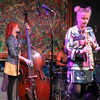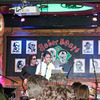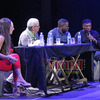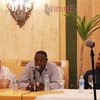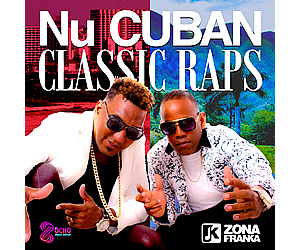Indice - Table of contents
New Stuff[hide]
Reportes: From The St... : Jazz Plaza ...
Fotos: Tom Ehrlich : Irakere 50th Annivers...
Fotos: Tom Ehrlich : Irakere
Resenas: Joey Altruda Presents: El Gran ...
Reportes: From The St... : Cubadisco 2...
Timbapedia: 09. Interviews -... : Carlos del Pino ...
Fotos: Tom Ehrlich : 2023 Monterey Jazz Fe...
Fotos: Tom Ehrlich : 2023 Monterey Jazz Fe...
Fotos: Tom Ehrlich : 2023 Monterey Jazz Fe...
Fotos: Tom Ehrlich : 2023 Monterey Jazz Fe...
Grupos: Tirso Duarte
Grupos: Tirso Duarte : Discography
Grupos: Charanga Habaner... : 8. El bla bla bla
Grupos: Pupy y los que S... : Tirso Duarte
Photos of the Day [hide]
SpanishEnglishStudy - Clave Changes - The Three Types of Clave Change
The Three Types of Clave Change: 2 & 3) "Clave License Style" or "jumping the clave" - you have to play either the "2" or the "3" side twice in a row to keep in sync with the music. This category is divided into those clave changes which require the "2" side to be played twice and those which require the "3" side to be played twice, but this is sometimes subjective as there is usually no one actually marking the clave during the change. When it's obvious, we use "2:2 Clave License" to refer to a clave change where it's necessary to play the "2" side twice in a row and "3:3 Clave License" when the "3" side must be played twice. Here's an example of a 3:3 Clave License change. [audio example 31] Notes on terminology: Juan Formell coined the phrase "clave license", but we made up the term "New York style clave change" to describe a very real phenomenon which definitely did not originate in New York! You've got to call it something and we just liked that term because NY arrangers like Marty Sheller have created so much great music for Ruben Blades, the Fania All-Stars, etc. using this technique. If you don't like the term, paste this article into your word processor and do a search and replace!
1) "New York style" or "continuous" - you can play clave from the beginning of the song to the end without clashing with the music and without ever having to play the "2" or "3" side twice in a row. The non-percussion parts change their phrasing so the the listener perceives the clave changing from 2:3 to 3:2 or vice versa, but the sequence of 2:3:2:3:2:3 etc. continues uninterrupted. Here's an example of a New York style clave change, explained in much greater detail below. The change occurs just before the voices give way to the horns. [audio example 20]










